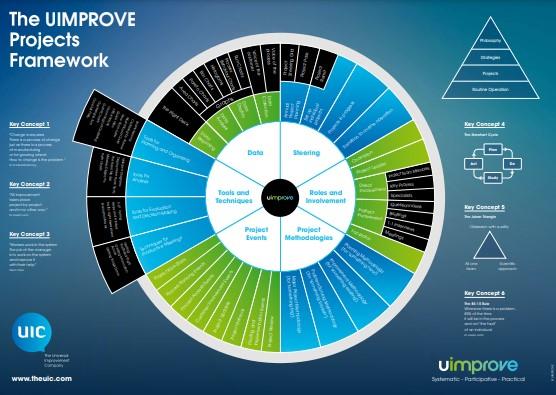Tips for successful scoping
‘Scope creep’ is a phrase familiar to most people involved in projects. As with so many aspects of project work, it can be avoided if the right time and effort is invested in scoping up-front. Read on to find out how to do this, and what do when the creep kicks in.

What is project scoping and why is it important?
Scoping is a crucial activity at the beginning of any project, large or small. It maps to the ‘Planning’ stage of the Plan-Do-Study-Act (PDSA or Shewhart Cycle) cycle and comes before project planning itself.
A good project scope fleshes out high-level objectives and identifies what is included and what is not when it comes to project deliverables.
It should act as springboard for project planning and inform what data you gather and how to help move your project forward.
Enthusiasm in the early stages of projects can often see teams jump straight into planning mode without first taking the time to identify scope. This issue is compounded when objectives are not clearly defined.
Where scope is vague or ill-defined, you are heading for a lot of wasted resource and energy, plenty of confusion and potentially a failed project. It is therefore vital to invest the time and thinking up-front in getting the scope right.
Anyone can write down a set of parameters and call it a scope. However, getting the process of scoping right is as important as arriving at a set of clearly defined boundaries around your project. This is about involving the right people, in the right way, at the right time.
Who needs to be involved?
Project scoping is about getting an early understanding of the likely impact of a project on routine operation, testing any assumptions and ensuring the project delivers maximum value for customers and stakeholders.
Scoping is not an ivory tower activity and often requires meaningful input from a range of stakeholders. Those responsible for leading and championing the project should work closely together to identify whose input is needed and how it should be obtained. This is likely to involve those whose day-to-day work will be affected by changes (e.g. front-line staff), corporate or support services (IT, HR), and other managers with a keen interest in the project’s outcomes.
Sometimes the scope of a project will be obvious (e.g. where legislation prescribes a change in process). However, even in these instances it is important to consider likely impacts on routine operation and get the views and insight of people doing this work. Managers – and even the best Project Leaders – have blind spots.
What is included?
Any project scoping exercise should consider inclusions and exclusions when it comes to:
- Departments and work areas
- Sites and locations
- Different groups of staff
- Other organisations to be involved or consulted
- Process boundaries (i.e. from what stage to what stage?)
- Any benchmarks from other organisations or industries
- Any other data required
What project scoping is not
- Project planning – there can often be a temptation to get on with Project Planning once a few scoping questions have been answered. Proper scoping involves gathering insight and reflecting on this before proceeding to the planning stage.
- Getting ‘buy-in’ – while winning support for project objectives is essential, there are some who focus heavily on this aspect of scoping (particularly at Project Kick-Starts), at the cost of properly using the outputs to determine what happens next
- A bit of paperwork to be signed off
How do I capture and document the project scope?
The starting place for capturing the scope of a project is the Project Remit. In the early stages, the scope will likely be iterative and you’ll need a few goes before getting it right. There may be a few revisions of the Project Remit required before detailed project planning takes place.
For large-scale, complex or mission-critical projects, the best way to scope a project is through a Project Kick-Start. UIMPROVE Facilitators are trained to run these events, or we can run one for you.
What can trigger a change in scope?
Changes in scope should be deliberative and take into consideration any input the project has received in its early stages.
Typical triggers for re-scoping include:
- Scope creep
- External events
- Internal restructure
- New opportunities e.g. funding, partnerships
- A change in organisational strategy
How to tackle scope creep
Scope creep can sometimes begin with a hunch – it’s important that Project Team members are alive to feedback and bring any concerns to Project Team Meetings with them.
A preventative approach is always best to avoid scope creep. A good Project Team Meetings structure should provide a regular health-check and utilise the Project Remit to help keep projects on-track and within scope.
Where it is clear that scope creep has crept in, a Project Refocus can often be the best way to get things back on-track. Again, UIMPROVE Facilitators are trained to run these events.
Tips for effective project scoping
If you are leading a project, have a first go at identifying the scope with your Champion and capture this in the Project Remit, then:
- Brainstorm all the questions that need answering about the project up-front
- Brainstorm everyone you need input from to inform your scope
- From there, identify whether the project would benefit from a Project-Kick-Start
- When thinking about customer-facing projects, the Kano Model can be a great tool for ensuring you focus your deliverables on what matters
Once the project is scoped, ensure this is reviewed at the next Project Team Meeting (usually through a brief-in of the Project Remit followed by Reflections/Small Group Work)
Conclusion
In conclusion, effective project scoping is the cornerstone of successful project management. It’s about laying a solid foundation by clearly defining what your project will – and just as importantly, will not – include. Remember, a well-scoped project not only sets clear boundaries but also provides a roadmap for all stakeholders involved. As you embark on your project management journey, keep these tips in mind: engage with key stakeholders early, use tools like the Kano Model for customer-centric projects, and always be vigilant against scope creep.
With these strategies in hand, you’re well on your way to leading projects that are well-defined, manageable, and aligned with your organisational goals. Remember, the time and effort invested in scoping your project effectively will pay dividends in the long run, leading to more efficient use of resources and greater satisfaction for everyone involved.
Need a little help with your scoping?
The Complete Guide to Improvement contains bountiful advice on scoping, and in particular any questions you need to ask as part of a Project Kick-Start or other scoping exercise. To get your hands on one, attend one of our training courses or get in touch to find out how we can help you and your organisation.





